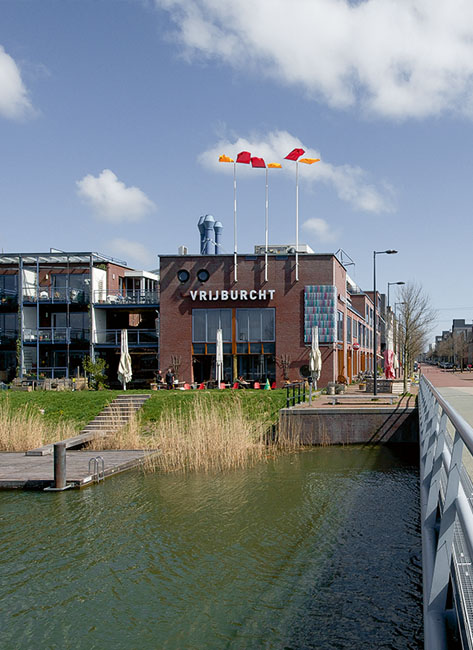Vrijburcht Amsterdam
CASA
Samenvatting
In 2000 schreef de gemeente Amsterdam een prijsvraag uit voor een collectief woongebouw op de zuidwestelijke punt van het Steigereiland. Het Steigereiland is onderdeel van de uitbreidingswijk IJburg die bestaat uit een reeks kunstmatig aangelegde eilanden in het IJmeer. Op het Steigereiland werd door de gemeente ruim baan gegeven aan het experiment, waaronder ook veel kavels voor zowel particulier als collectief opdrachtgeverschap. Vanwege de prijsvraag werd de Stichting Vrijburcht opgericht, bestaande uit een groep vrienden onder welke architect Hein de Haan van CASA architecten. Het plan van de stichting werd geselecteerd voor de locatie. Als voorbeeld diende het eerder door CASA ontwikkelde woongebouw BO1 in het Oostelijk Havengebied van Amsterdam. Een belangrijke rol was weggelegd voor woonstichting De Key die garant stond in de ontwikkelingsfase en een aantal onderdelen van het project blijvend beheert.
De bebouwing bestaat uit een gesloten bouwblok rondom een gemeenschappelijk groen binnenterrein. Alle woningen zijn bereikbaar vanaf dit binnenterrein. De brede galerij op de eerste verdieping vormt naar voorbeeld van het beroemde Justus van Effenblok van architect Brinkman in Rotterdam een opgetilde straat of deck als tweede collectieve buitenruimte naast de op het maaiveld gelegen binnenhof. Vanaf het deck kunnen via trappen de woningen op de derde en vierde bouwlaag bereikt worden. Het diepe volume aan de waterkant is opgebouwd uit drie boven elkaar gelegen appartementen die toegankelijk zijn door middel van trappenhuizen in lichthoven midden in het volume. Deze hoven worden vanuit de binnentuin bereikt via smalle overbouwde doorgangen. Hein de Haan ontwierp voor de woningen een basisstructuur die veel mogelijkheden toestond voor een persoonlijke uitwerking. In het blok bevindt zich ook een aantal zorgwoningen. Er wordt geparkeerd in een ondergrondse, gemeenschappelijke parkeerruimte.



